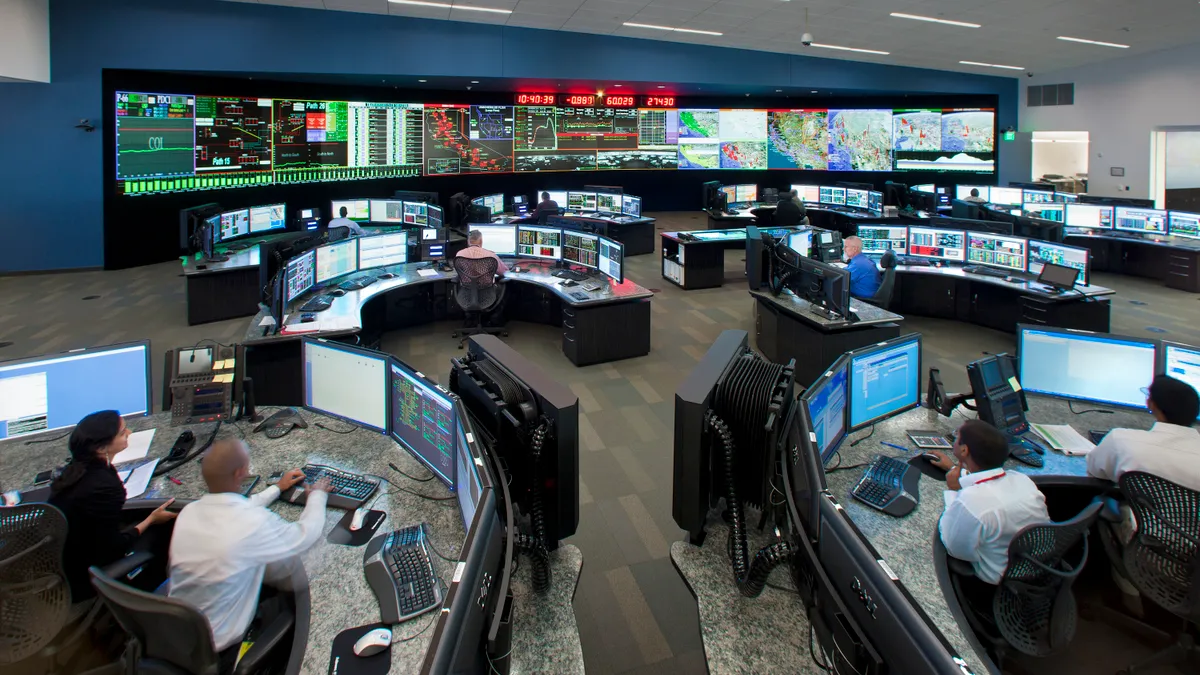UPDATED: April 23, 2021: The California Independent System Operator’s board of governors this week adopted a suite of market and operational improvements that are aimed at supporting the power grid when supply is tight. The initiative, if approved by the Federal Energy Regulatory Commission, will remain in effect until May 31, 2022.
The initiative would “refine the prioritization of energy imports, exports, and transfers through the ISO’s balancing authority area,” according to CAISO, better equipping it to cope with transactions during electricity shortages, such as the situation in August last year that led to rolling blackouts.
Dive Brief:
- California's energy agencies will soon release a final root cause analysis of the rolling blackouts that affected the state this past August, and the California Independent System Operator (CAISO) has focused its efforts on preparing for summer 2021, according to executives.
- The final analysis is expected to point to three contributing factors — the climate-change induced heat storm in the Western U.S., changing supply and demand patterns, as well as market practices that exacerbated the problem, CAISO's new Chief Operating Officer and Senior Vice President Mark Rothleder said during a webinar organized by the Clean Coalition on Wednesday.
- "Our efforts are currently focused on preparing for the next summer, summer 2021. While additional capacity is coming online, vulnerabilities and the need for additional capacity will exist for several years," as the system navigates the retirement of a slate of natural gas plants by 2023 and the Diablo Canyon nuclear facility by 2025, Rothleder explained.
Dive Insight:
The grid operator and regulators issued a preliminary analysis of the blackouts that affected California on Aug. 14 and Aug. 15 earlier this year, pointing to similar factors: the heat storm and inadequate resource planning targets included.
"August was clearly, I think, a pivotal moment for the state and I think we all recognize that it is essential that we develop a clear-eyed understanding of the root causes of the summer event[s]," CAISO President and CEO Elliot Mainzer, who took over the grid operator in late September, said on the webinar.
The final report is being developed by CAISO along with the California Public Utilities Commission (CPUC) and California Energy Commission, and is anticipated to be done by the end of this year. It is expected to reflect additional analysis of demand response resource performance, as well as information on some of the differences between scheduling and actual load, according to Rothleder.
But the top-line takeaways align with the preliminary analysis, including the finding that gross peak conditions are extending into the evening period when behind-the-meter and grid-side solar reduces and load returns to the system.
"We've advocated for several years that the resource adequacy process needs to start focusing the attention on these later evening hours, not just the gross peak hours," Rothleder said.
A lot of the new capacity in California coming online before next summer will be storage resources, and the ISO has been working on developing enhancements to ensure they can be effectively managed. However, many of those changes will only be in effect next fall, Rothleder said.
"In the interim, we will ensure storage resource providers understand how we expect them to operate the system so that storage is available when needed to meet the challenging net peak demand in the stressed summer conditions," he added.
CPUC rulemaking on 2021 reliability moves forward
The CPUC, meanwhile, opened a rulemaking last month focused on ensuring a reliable power grid during potential extreme weather events in the summer of 2021. CAISO filed comments in that proceeding last week, recommending increasing planning reserve margins from 15% to 20% from June through October 2021, and applying it to both the gross peak as well as the evening hours when solar production drops off.
Environmental advocates, meanwhile, raised concerns of their own in comments, specifically about the possibility of extending the life of natural gas plants scheduled to retire soon, and relying on backup diesel generators.
In addition, the commission should "reduce barriers to demand response participation and... maximize demand response programs as an essential tool for fluctuating demand," the California Environmental Justice Alliance, Sierra Club, Union of Concerned Scientists and Grid Alternatives said in joint comments.
As part of its comments, CAISO also urged the commission to specify that unit specific resource performance and bidding data should not be included in the discovery process of the proceeding, stating that while aggregated information might be relevant, data requests for individual unit performance "are likely to be unduly burdensome, expensive, and intrusive."
When asked about this during the webinar, Mainzer said he thinks that that recommendation was made to move the proceeding forward as expeditiously as possible, to accelerate any procurement or any demand-side actions needed before next summer.
"If there is a perception that somehow we're trying not to provide good and transparent information, or if that's translating into reality, that's something I would want to look at," he said.















